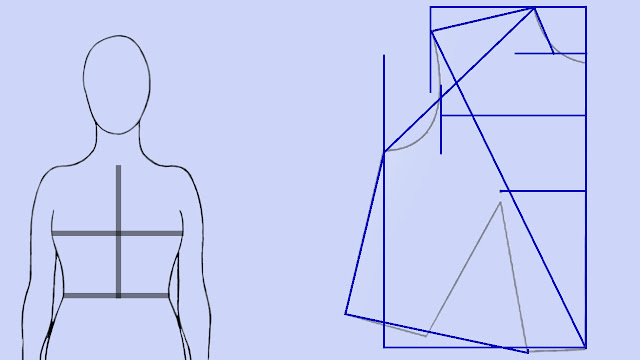Following up with our pattern drafting series, our next block is our bodice!!! Today, I'm only focusing on the front half of our bodice; otherwise, this post would be extremely long. If you would rather watch this tutorial, there is video at the end of the post.
A few things we need to know about this pattern.
1. This block is made for woven fabrics (ie. non-stretchy fabrics)
2. This block stops at your natural waist (which is also where we will take measurements from)
3. The term "square out"/ "square down" means the line you are drawing will be at a 90 degree angle to the current line. You can use an L square or in a pinch you can use one of those clear rulers with eighth inch line markings.
3. You will need this block later on to create full length blouses, dresses, jackets, bras, swimsuits, and even to create our knit bodice block so you can make tees!
Let's get started!!!!
1. To start off, we're going to draw a straight line measuring the length from the highest point on our shoulder straight down to our waist.
2. From the top of that line we are going to square out using measurement from the pit of our neck to our shoulder tip.
3. Then from the end of a that line we're going to square down three inches.
4. Next, we're going to take the measurement from the pit of our neck to our waist, and we're going to measure up from the very first vertical line that we drew. From there, we're going to square out four inches.
5. Next we're going to measure from center front over over our apex to our side seam. If you're using a dress form that's going to be about two inches below your arm plate. Using that measurement we're
going to square out from our first vertical line adding a quarter of an inch for ease.
going to square out from our first vertical line adding a quarter of an inch for ease.
6. From the end of that line, we're going to square up about 11 inches.
7. Next we're going to measure from our shoulder tip to our center front waist and add one eighth of an inch. Using that measurement we're going to draw a straight line starting from our bottom right corner and rotating that line until it touches our shorter three inch line at the top left corner.
8. From the end of our diagonal line, we're going to draw a second line that's going to
measure the length of our shoulder, and we're going to rotate that until it touches our top horizontal line.
measure the length of our shoulder, and we're going to rotate that until it touches our top horizontal line.
9. From there, we're going to square down until it touches our other horizontal line directly below it.
10. Starting from the top of our diagonal line, we're going to measure down the distance from our shoulder tip to our apex.
11. Then take your measurement from apex to apex and divide by two and add one
quarter of an inch. Using that measurement we're going to square out from center front and go through the mark that we made on the diagonal line. Your measurements may or may not go past that diagonal line.
quarter of an inch. Using that measurement we're going to square out from center front and go through the mark that we made on the diagonal line. Your measurements may or may not go past that diagonal line.
12. Next we're going to measure from center front across our chest to our mid armhole and add a quarter of an inch. Half way between our top two horizontal lines we're going to use this measurement to square out from center front.
13. then square up and down at the
end of that line.
end of that line.
14. Next we're going to find our dart placement, which is usually about halfway between your center front and your side seam and directly below your bust point. Use this measurement to make a mark on
your center front waist.
your center front waist.
15. Then, square down three sixteenths of an inch.
16. Next, we're going to take our strap measurement and this is going to be from our highest point on our shoulder to our side seams plus three eighths of an inch. Using this measurement, we're going to draw a line starting at the intersection of our shoulder and neck line and rotating it until it hits our far left vertical line.
17. Next, we're going to take our side seam measurement, and we're going to draw a line that starts at the intersection of our last line that we drew and the vertical line, and we're going to swing that out until the bottom of that line is one and one quarter inch away from that vertical line.
18. Now connect the end of that line to our dart placement line that we drew earlier.
19. Now, we're going to take our center front waist to side seam measurement, add one quarter of an inch, and subtract our dart placement measurement.Using this measurement
we're going to measure out from our dart placement line along our diagonal line
that's connecting to our side seam.
we're going to measure out from our dart placement line along our diagonal line
that's connecting to our side seam.
20. Draw a straight line from your apex to your first dart placement point, and measure. This is going to be our first dart leg.
21. To create our second dart leg we're going to take that measurement and we're going to draw a second line from our apex to our other point that we just created along that waistline. Because our waist lines are curved, this new line will probably go past the diagonal line that we drew from our side seam to our dart placement point.
22. Now since we don't want to sew a dart all the way up to our apex, we are going to find the center of these two dart leg points and we are going to draw a line from that center point up to our apex and then along that point we're going to measure down from the apex on that line five eighths of an inch. This is going to be our new dart point.
23. So you can go ahead and connect the lines from our two dart legs to that dart point and that is what we are going to be sewing.
24. Now to create our waistline, we're going to connect our side seam line to our new dart leg point and it's probably going to be curved since our waist lines are curve
25. and we're also going to connect our center front to our right dart leg.
26. To make our neck line we're going to lower it by three-eighths of an inch and square out about a quarter of an inch along center front, and we're going to use a French curve to connect our shoulder seam to this line making sure that we bump it out towards the left one eighth of an inch.
27. To draw our armhole we're going to do the same thing by making sure that our French curve does not go past our vertical guideline that we created at our mid armhole, and then it's going to
connect from our shoulder tip to our side seam.
connect from our shoulder tip to our side seam.
28. We're done! At this point, some people like to leave their block as is, but I personally like to add seam allowance, notches, punch holes, and true my seams and darts.
Whew!!! We're done with the front! I know there are several steps, but I promise it doesn't take nearly as long as you would think. Don't forget to keep all of your measurements! You never know when you will need them, and I promise the second you do nobody will be around to help you!
TAGS :
block |
bodice |
bodice front |
diy |
draft |
drafting |
front |
pattern |
pattern drafting |
sewing |
sewing from scratch |
sloper |
tutorial |
tutorials |
































COMMENTS